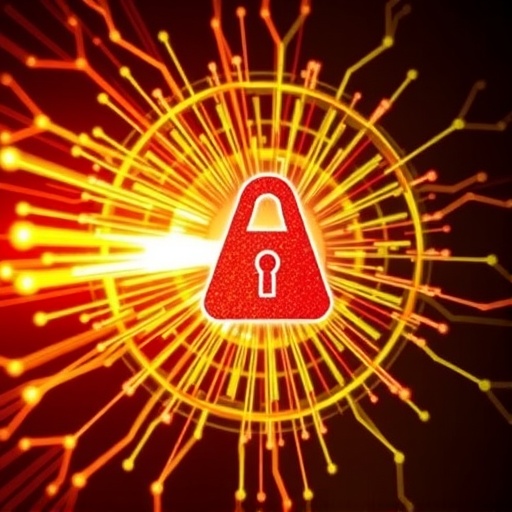
In a remarkable leap forward for secure communication technology, an international team of researchers has unveiled an innovative method for quantum key distribution (QKD) that promises enhanced practicality and resilience for real-world applications. This breakthrough pivots around the successful experimental demonstration of composable secure key generation employing discrete-modulated continuous-variable quantum cryptography (DM CV-QKD). The findings, recently published in Light: Science & Applications, not only advance the theoretical framework of quantum cryptography but also bridge the gap toward integrating quantum security protocols within existing telecommunication infrastructures.
Quantum key distribution is hailed as the cornerstone for future-proofing data security, leveraging the fundamental principles of quantum mechanics to enable unconditionally secure key sharing between communicating parties. Conventional encryption techniques face looming threats from the advent of quantum computing, which could potentially unravel classical cryptographic codes. In contrast, QKD harnesses quantum states that are inherently fragile and cannot be cloned without detection, ensuring forward security by design. This guarantees that even if adversaries acquire powerful quantum processors in the future, previously intercepted keys remain indecipherable.
Among the various approaches to QKD, continuous-variable (CV) protocols distinguish themselves by their compatibility with standard components used in today’s fiber optic networks. CV-QKD encodes information onto continuous electromagnetic field quadratures and can utilize homodyne or heterodyne detection, facilitating the use of conventional telecom hardware and enabling potentially higher key rates over metropolitan-scale distances. However, the most studied form of CV-QKD relies on Gaussian modulation schemes that, while elegant in theory, encounter formidable obstacles in practice. These schemes demand near-perfect hardware precision and an abundance of random number generation, making scalable deployment daunting.
.adsslot_Vgu9kPAmSj{width:728px !important;height:90px !important;}
@media(max-width:1199px){ .adsslot_Vgu9kPAmSj{width:468px !important;height:60px !important;}
}
@media(max-width:767px){ .adsslot_Vgu9kPAmSj{width:320px !important;height:50px !important;}
}
ADVERTISEMENT
To circumvent these practical bottlenecks, the research consortium adopted a discrete modulation strategy for continuous-variable QKD, opting for quadrature phase-shift keying (QPSK) encoding. This method restricts the quantum states to four non-orthogonal coherent states, significantly simplifying the quantum state preparation and detection apparatus. The reduced complexity eases engineering constraints and diminishes the sheer volume of random data needed, aligning well with current optical telecommunication systems. Despite these clear advantages, discrete modulation introduces asymmetries that complicate rigorous security proofs, posing a notable theoretical challenge.
Composability serves as a vital criterion in evaluating the security of cryptographic protocols, demanding that security guarantees remain intact under arbitrary combinations with other cryptographic tasks. Real-world communication systems integrate numerous layered protocols, so a composable security framework is essential to ensure that keys generated via QKD protocols can safely underpin applications such as encrypted messaging or secure financial transactions. Although promising in principle, prior to this demonstration, no CV-QKD system using discrete modulation had been experimentally validated to provide such robust composable security assurances.
The team’s experimental setup involved transmitting quantum signals encoded with QPSK modulation through 20 kilometers of standard single-mode optical fiber, reflective of practical metropolitan telecommunication networks. By meticulously blending advanced theoretical modeling with state-of-the-art experimental techniques, the researchers achieved a secure key rate of approximately 0.011 bits per symbol. This rate, while modest, is notable given the stringent composable security constraints and the utilization of relatively simple, cost-effective telecom components.
Critical to this achievement was the integration of precise digital postprocessing algorithms that reconciled the raw quantum data with error correction and privacy amplification procedures, ensuring that the final cryptographic keys met rigorous security thresholds. The researchers highlighted the importance of harmonizing theory, experiment, and classical data processing to validate the composed system’s security in realistic noisy environments, where imperfections and potential eavesdropping attempts are inevitable.
This accomplishment signals a transformative step towards democratizing quantum-secure communication. By demonstrating that DM CV-QKD can be deployed over existing fiber optic networks with composable security guarantees, the study alleviates longstanding concerns regarding scalability and practical implementation. The implications extend beyond academia, offering a viable pathway for network operators and industries dependent on sensitive data exchange to future-proof their communication channels.
Moreover, this work underscores the adaptability of continuous-variable quantum communication systems. The compatibility of discrete modulation schemes with standard telecom hardware reduces barriers to entry, fostering opportunities for rapid adoption. The researchers emphasize that the modular nature of their approach facilitates integration into current telecommunication frameworks, providing a pragmatic route to quantum-enhanced security without overhauling existing infrastructure.
The broader vision illuminated by this research encompasses securing a wide array of digital transactions — from confidential governmental communications to private healthcare data and financial services. As cyber threats grow more sophisticated, the need for cryptographic methods resistant to both classical and future quantum adversaries becomes paramount. The proof-of-concept demonstrated here invigorates efforts to develop end-to-end quantum-secure networks that can operate efficiently and reliably under realistic conditions.
Looking ahead, the team plans to extend their work by increasing transmission distances, refining key rates, and exploring adaptive modulation schemes to enhance performance further. Additional research will also delve into integrating the presented protocol with multiplexed communication channels and advanced error correction codes to push the boundaries of secure key distribution rates and resilience.
In conclusion, this pioneering experiment aligns with an evolving global agenda aiming to embed quantum security at the heart of digital communication infrastructures. The successful realization of composable security within discrete-modulated CV-QKD epitomizes the fusion of foundational quantum physics with practical engineering, heralding a future where unbreakable encryption is not just theoretical but an operational standard. As quantum technologies continue to mature, such advances will be pivotal in safeguarding data sovereignty and privacy across numerous sectors worldwide.
Subject of Research: Experimental demonstration of composable secure key distribution using discrete-modulated continuous-variable quantum cryptography.
Article Title: Experimental composable key distribution using discrete-modulated continuous variable quantum cryptography
Web References: DOI link
Image Credits: Adnan A. E. Hajomer et al.
Keywords
Quantum key distribution, continuous-variable QKD, discrete modulation, composable security, quantum cryptography, quadrature phase-shift keying, telecom networks, quantum communication, secure key generation, quantum-safe encryption
Tags: continuous-variable quantum cryptographydiscrete-modulated continuous-variable QKDexperimental quantum communicationfiber optic network integrationfuture-proof data securityquantum computing threatsquantum cryptography advancementsquantum key distributionresilient encryption methodssecure communication technologytelecommunication security protocolsunconditionally secure key sharing





